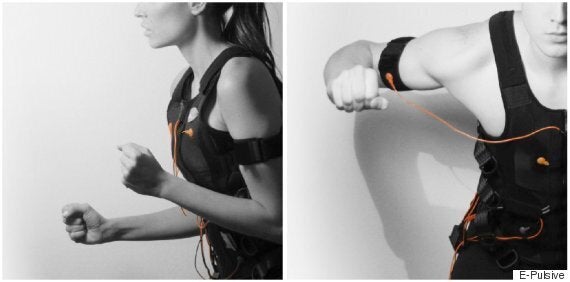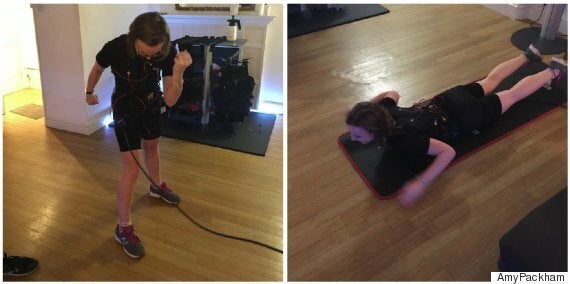As much as I enjoy working out, being told a 20-minute session of Electric Muscle Stimulation (EMS) could deliver the equivalent of 90 minutes HIIT training was music to my ears.
EMS is the use of electric impulses to make our muscles contract while we're doing a workout, making it a lot more intense than usual.
The concept is fairly new to London-based fitness fanatics, with only a handful of gyms offering it, giving me even more of an incentive to try it out.
What is it?
EMS sessions are carried out by a personal trainer. The session involves wearing an EMS bodysuit (a bit like a wet suit) that delivers currents to different body parts to reach deep muscle layers hard to activate through conventional training.
You can choose the level of electric pulse you're comfortable with and then target specific body parts (abs, arms, legs) depending on your own goals.
EMS is training is said to recruit up to 98% of muscles during a workout, compared to the usual 50% in a normal workout, I'm told. Once the pulses are activated you do a short, 20-minute workout.

How does it work?
Mario Kaspers, co-founder of E-Pulsive, that runs EMS training told me: "The electric current causes several muscle contractions per second (the exact number depends on the workout settings).
"The contractions are as strong as conventional contractions from lifting heavy weights without putting any pressure on your back, knees and shoulders. Therefore the electric current replaces weights and hence enhances the workout significantly."
He tells me EMS is better for strength training over cardio due to the speed at which results can be obtained ("noticeable results can be seen after four sessions", he said).
The science can get confusing, but I asked what's happening to our bodies during a session. During a conventional workout I'm told our muscles are controlled by the central nervous system to cause contraction and therefore movement. In EMS training, however, the muscles receive external electrical impulses, allowing them to contract without a signal from the central nervous system.
Kaspers said people who train with EMS regularly are advised to have one to two sessions per week and they're so intense that they can replace two regular gym sessions. So for busy people, you can definitely see the benefits.
The verdict
I was told the E-Pulsive, 20-minute session could burn up to 500 calories.
Once I was suited up and attached to the EMS machine, the trainer started the electric impulses by slowly adding them to each body part on my bodysuit. The sensation was strange, like a slightly aggressive vibration on my body. When I'd reached the point where I felt comfortable with the level of the pulses, it was time to actually workout. The pulses were continuously on for around 8 seconds, then off for 8 seconds, for the whole 20 minutes.
In the warm up I did star jumps, high kicks and high knees. You'd be surprised how hard it is to do 20 of each with the EMS machine on. I was sweating like crazy within four minutes. I asked Kaspers if this was normal or if I was just insanely unfit, but he assured me it was totally expected.

The actual workout was pretty simple - we did a range of crunches, leg lifts, planks and squats - but it was much, much harder than my 40-minute HIIT class. When the pulses were active, trying to crunch or plank became so difficult that I had to keep being reminded to "keep going" and "carry on". I was just waiting for that short relief when the pulses stop for a few seconds.
It wasn't painful and not really that uncomfortable - just a really hard workout. By the end of the 20 minutes, my hair was dripping and I quickly realised why the sessions were so short.
24 hours after: My abs, thighs, calves and glutes were really feeling it the next day. It was the feeling you have after a intense legs session at the gym when you just know you pushed yourself. I felt like I'd done about 200 squats when in reality I did about 20.
48 hours after: I was warned two days after was when I would feel it most and he was right. It was painful to sit down on my chair, to go the the loo and even to walk up the stairs. Funnily enough, the muscles that ached the most (glutes and calves) were the muscles I was told by a physio previously were the weakest, which makes sense.
EMS definitely does what it says on the tin - an intense 20-minute workout achieving results of a much longer session. If money wasn't an issue, I'd be all for it. Sadly my bank account can't cope with £40 per session but if yours could, I'd give it a go.